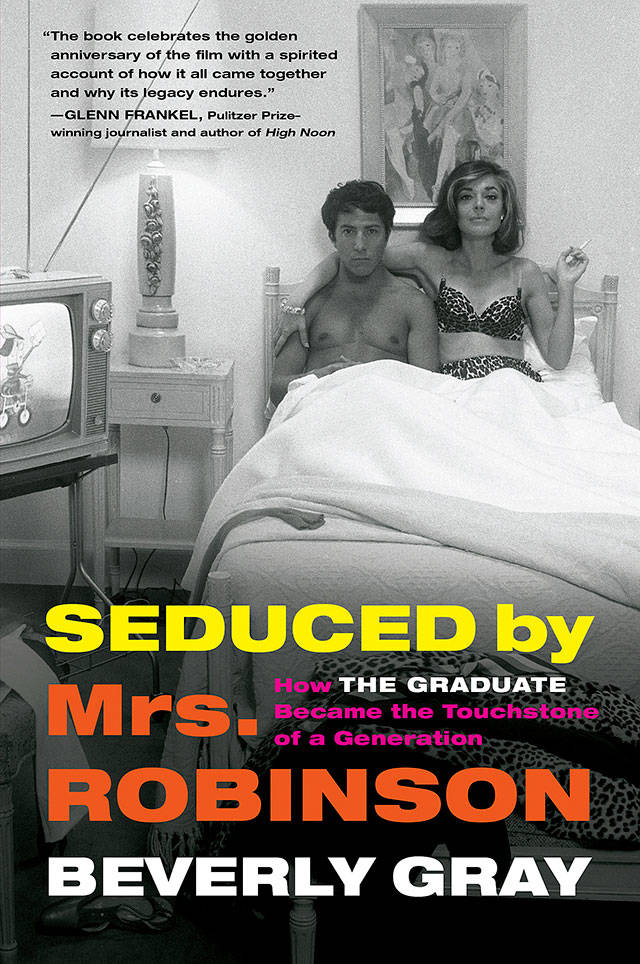By Amy Henderson / The Washington Post
Is 50 the new 20? Does “The Graduate” — a blockbuster movie celebrating its 50th anniversary this year — retain the flush of youth?
Beverly Gray argues that it does, and has written “Seduced by Mrs. Robinson” to explore how an obscure novel, a neophyte film director, unlikely casting and a pop music score revolutionized post-studio Hollywood.
Gray uses a “making of” approach to examine how this mash-up of a movie made magic. The key figure was director Mike Nichols, who turned to movies after his comedy partnership with Elaine May dissolved. Nichols framed “The Graduate” as a story about young boomers rejecting the mid-century world honed by their parents. Twenty-one-year-old Benjamin Braddock is the touchstone, the prototype for a new generation’s “general malaise.”
As fans of the movie know, Benjamin’s parents live in Los Angeles. When he returns from college in the East, he feels trapped in a hometown where now, Gray writes, he “can see and be seen, but remains forever cut off.” His parents throw him a graduation party and give him a frogman’s outfit. Mr. Braddock forces him to don the scuba suit and jump into the family pool, and Nichols shapes that scene to portray the submerged Benjamin as “some exotic, but glassed-in sea creature, placed on exhibit to dazzle his parents’ friends.” To the Braddocks, Benjamin is their “trophy son.”
For the role of Benjamin, Nichols cast against type. Instead of a Southern California hunk, he selected a still-unknown Dustin Hoffman. Nichols said he identified with Hoffman, currently under fire for alleged sexual misconduct, as “a short, dark, Jewish, anomalous presence, which is how I experience myself.” Nichols wanted Benjamin to radiate the discomfort of an outsider — to know only that he didn’t want to be submerged in the world of his parents.
Nichols chose respected actress Anne Bancroft as the seductress, and he framed Mrs. Robinson as a predator. Her wardrobe evoked tiger and leopard motifs, and she wore extravagant furs. “All her clothes are animals,” Nichols said. Yet Mrs. Robinson was only a diversion. She is part of an older world, and Nichols told Hoffman to imagine that Benjamin “is still in bed with his parents’ generation.”
Benjamin suddenly finds purpose by falling in love with Mrs. Robinson’s daughter, Elaine. She is marrying someone else, but nothing stops Benjamin once he’s in command mode. He grabs Elaine from her wedding and whisks her off on a city bus. They both look confused, and the movie ends ambiguously as “The Sound of Silence” plays in the background. Is darkness ahead, or is the bus heading into a sunset?
Gray views their future with optimism, suggesting that “whatever age you may be, if the vision that was planted in your brain still flickers, it’s a sign you retain a shard of Benjamin Braddock’s youthful capacity for hope and wonder.”
Will the wonder last? Ben’s self-discovery is what attracted Gray to write “Seduced by Mrs. Robinson” in the first place. Growing up in the ’60s, she embraced “The Graduate” because it made her understand “how badly we wanted to distance ourselves from the world of our parents.” Fifty years later, she has adopted the movie as a generational template, and for most of the book she writes smartly and insightfully about how the characters were shaped by a disruptive age.
The final section focuses on how “The Graduate” became a transformative force in Hollywood filmmaking, but here Gray’s discussion tends to ramble. Despite this weakness, though, the book as a whole offers a fascinating look at how this movie tells a timeless story: that life is always about making choices.
Seduced by Mrs. Robinson: How “The Graduate” Became the Touchstone of a Generation
By Beverly Gray
Algonquin. 304 pages. $24.95.
Talk to us
> Give us your news tips.
> Send us a letter to the editor.
> More Herald contact information.

























